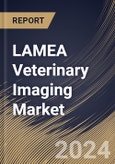Equine veterinary care has significantly improved by incorporating imaging technologies tailored for horses. From lameness evaluations using digital radiography to detailed soft tissue imaging through MRI, equine veterinarians leverage a range of modalities to diagnose orthopedic and internal conditions. Equine imaging is crucial for performance evaluation, pre-purchase examinations, and the overall well-being of horses. Digital radiography has revolutionized lameness evaluations in horses. Traditional radiography, using film-based images, has been replaced by digital systems that provide immediate, high-resolution images. Equine veterinarians use digital radiography to examine bones and joints, aiding in diagnosing lameness and orthopedic conditions. The digital format allows for efficient image storage, sharing, and precise analysis of the equine musculoskeletal system.
In addition, veterinary imaging extends its reach to exotic and wildlife medicine, where non-traditional companion animals and wild species benefit from advanced diagnostics. Zoological institutions, wildlife rehabilitation centers, and conservation efforts rely on imaging technologies to assess the health of diverse species, enabling targeted interventions and informed conservation strategies.
As the number of pet owners in Brazil increases, there is likely to be a higher demand for veterinary services, including diagnostic imaging. This trend is often associated with a growing middle class, urbanization, and changing lifestyles, all of which contribute to the increased adoption of pets. Therefore, with the rising pet ownership in the LAMEA region, there will be increased growth in the regional veterinary imaging market.
The Brazil market dominated the LAMEA Veterinary Imaging Market by Country in 2022, and would continue to be a dominant market till 2030; thereby, achieving a market value of $49.6 million by 2030. The Argentina market is showcasing a CAGR of 10.7% during (2023 - 2030). Additionally, The UAE market would register a CAGR of 9.8% during (2023 - 2030).
Based on Animal Type, the market is segmented into Small Animals, and Large Animals. Based on Product, the market is segmented into Instrument (X-ray, Ultrasound, MRI, CT Imaging, Video Endoscopy, and Others), Accessories/ Consumables, and Software. Based on End User, the market is segmented into Veterinary Clinics & Diagnostic Centers, and Veterinary Hospitals & Research Centers. Based on Application, the market is segmented into Orthopedics & Traumatology, Neurology, Oncology, Dental Application, Cardiology, Respiratory, and Others. Based on countries, the market is segmented into Brazil, Argentina, UAE, Saudi Arabia, South Africa, Nigeria, and Rest of LAMEA.
List of Key Companies Profiled
- GE HealthCare Technologies, Inc.
- Agfa-Gevaert N.V. (IG Farben)
- Esaote SpA
- IDEXX Laboratories, Inc.
- Heska Corporation (Antech Diagnostics, Inc)
- Siemens Healthineers AG (Siemens AG)
- Fujifilm Holdings Corporation
- Mindray Medical International Limited
- Samsung Electronics Co., Ltd. (Samsung Group)
- Canon, Inc.
Market Report Segmentation
By Animal Type- Small Animals
- Large Animals
- Instrument
- X-ray
- Ultrasound
- MRI
- CT Imaging
- Video Endoscopy
- Others
- Accessories/ Consumables
- Software
- Veterinary Clinics & Diagnostic Centers
- Veterinary Hospitals & Research Centers
- Orthopedics & Traumatology
- Neurology
- Oncology
- Dental Application
- Cardiology
- Respiratory
- Others
- Brazil
- Argentina
- UAE
- Saudi Arabia
- South Africa
- Nigeria
- Rest of LAMEA
Table of Contents
Companies Mentioned
- GE HealthCare Technologies, Inc.
- Agfa-Gevaert N.V. (IG Farben)
- Esaote SpA
- IDEXX Laboratories, Inc.
- Heska Corporation (Antech Diagnostics, Inc)
- Siemens Healthineers AG (Siemens AG)
- Fujifilm Holdings Corporation
- Mindray Medical International Limited
- Samsung Electronics Co., Ltd. (Samsung Group)
- Canon, Inc.
Methodology

LOADING...








